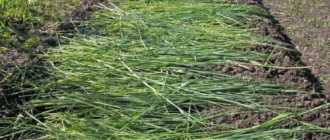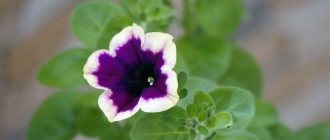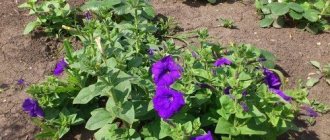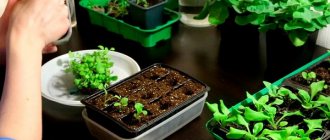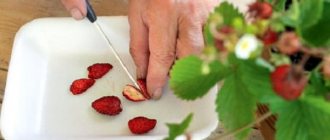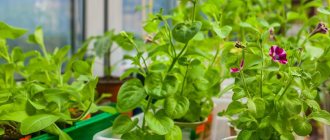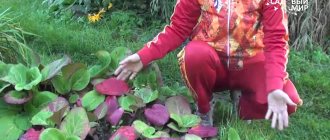Petunia business is the best way to make money from seedlings. Petunia is an ideal flower for trading; beautiful, easy to care for, has a lot of varieties and is sold in different variations (seedlings in cups, bushes in a pot, shoots, rooted cuttings, etc.).
The demand for petunia is higher than for other flower seedlings, but the number of sales depends on the quality of the bushes and the variety of varieties on the trading floor.
Advantages of business on petunia:
- The demand for petunia is much higher than for other seedlings of flowers and vegetables;
- The long sales season, reaching two and a half months, allows us to sell a significant number of flowers;
- Large percentage of profit (up to 500% of invested funds) in a short time (season);
- High share of income per unit produced (selling a box of blooming petunias will bring you 2-3 times more money than selling the same volume of tomatoes, marigolds, asters and other plants);
- Earning money from petunia seedlings is a promising, multi-faceted, developing business (it grows with increasing skills and experience of the entrepreneur).
Disadvantages of business on petunia:
- A high entry threshold (prices for petunia seeds of “elite varieties” are quite steep), plus a heated greenhouse made of special polycarbonate (protecting seedlings from burns caused by focusing ultraviolet - solar rays), will significantly strain the budget;
- They require deep knowledge and experience in growing flora (crooked ones are flowers that have not bloomed, they are reluctant to buy);
I recommend starting a petunia business in parallel with other widely consumed flowers (lobelia, viola, purslane, etc.). This eliminates costs and lost profits due to mistakes that you are sure to make.
Petunia growing business
A petunia growing business must be planned in the fall in order to have time to prepare for spring.
How to grow petunia for sale (in flower pots) in this video. Here you will learn the intricacies of this art and see with your own eyes the elementary nature of this matter (in theory, of course).
For a petunia growing business you will need:
- Build a greenhouse with a cellular polycarbonate roof designed specifically for growing plants. Don't take the cheap one! (underneath the petunia can stretch, burn, and the bush can become deformed, becoming asymmetrical);
- Provide illumination for petunias in cloudy (partially sunny) springs;
- Make racks at a height of 30 - 40 centimeters from the ground so that the seedlings are warm at night;
- Pull the mesh on the racks to keep the pots from falling over during watering (in the extended state).
- Buy seeds and be sure to check them for germination.
The diagram of a business for growing petunia with a full production cycle and sales of goods is shown in this structure.
An analysis of the presented plan demonstrates that the petunia growing business requires work all year round.
What documents are needed to open
The package of documents for running a flower business is not as large as for licensed activities. Traditionally, an entrepreneur will need:
- certificate confirming registration as an individual entrepreneur;
- a document confirming the payment of a single tax (with a simplified taxation scheme);
- rental agreement for a greenhouse and other premises, if necessary;
- passport details of hired persons;
- labor contracts concluded with employees;
- certificate of registration with the Pension Fund.
When to sow petunia for sale
Petunias for sale need to be sown several times a season, from January to March. This way you will earn more on sale, due to constantly flowering bushes, at the right time.
I advise you to sow petunia in three stages:
- In January - elite (expensive) seeds (for flowerpots and flowerpots). And when the time comes to form bushes (by pinching), try to root the cut cuttings for additional profit;
- In February - good varieties and hybrids (moderate price range), in large (500 ml) cells and liter pots, for sale to the middle class;
- Sow the last petunia seeds in March. Use uncommon, cheap varieties (prepare them for mass sales as a binder).
The amount of petunia required for each seeding depends on the market segment in which trade is carried out. The higher the social status of the trading platform, the greater the demand for expensive products.
Some gardeners sow petunia up to ten times per season in order to sell seedlings at the peak of flowering. This allows you to increase sales volumes and the price of goods.
I advise you to purchase petunia seeds from a decent seller who does not cheat with varieties and expired goods. For example, in the online store “Garshinka”.
LiveInternetLiveInternet
| Petunia blooms in the year of sowing, therefore it is often used as a summer plant, although if desired, your favorite plant can be dug up from the garden in the fall and kept at home until the next season, also propagated by cuttings. |
Agricultural technology of petunias
Since you sow petunia in winter, you need to take into account the fact that at this time the plants are more susceptible to various diseases (black leg, chlorosis,). Most of these diseases develop due to the fact that the plant lacks heat, light, and air. Therefore, when thinking about winter sowing, do not forget to make up for these deficiencies for the plants in advance. So, you finally decided to sow.
To obtain beautiful seedlings and abundant flowering, you need:
quality petunia seeds;
special substrate for petunia;
good water;
the right fertilizers at the right time.
Seeds
High-quality seeds are needed to have full-fledged and beautiful seedlings and flowers. There are two types of seeds - pure and coated. The latter have a number of advantages. Firstly, the shell protects the seeds from diseases and various mechanical damage, and secondly, it facilitates sowing - thanks to its large size, the seeds can be sown one at a time in a row. Uncoated seeds can be sprayed with succinic acid after planting, as the soil dries. This helps those seeds that are late in germination to grow faster.
Substrate for petunias
The substrate for sowing should not be very nutritious, and should be prepared on the basis of peat, that is, it should provide good drainage (electrical conductivity EC = 0.75-1.0). Soil acidity for petunias is pH 5.5-6.5 and NPK content (N-nitrogen 13, P-phosphorus 2, K-potassium 13 plus Ca-3Mg).
You can use the following formula to prepare the substrate yourself:
peat - one part;
rotted cow humus (vermicompost) - one part;
turf soil - 1/2 part;
wood ash for deoxidation (if necessary).
The soil is spilled with a fungicide (Previkur) to prevent the occurrence of “black leg”; You can also shed it with a dark pink solution of potassium permanganate.
Sowing petunias
Petunia has very small seeds, so you need to pay a lot of attention to developing small petunia seedlings and provide regular care.
Petunia seeds are sown for seedlings from February to the end of March (Fig. 1); sowing is superficial, without covering with soil. It is advisable to sow the seeds of petunia, as well as other small-seeded plants, rarely (so that the seedlings do not inhibit each other) and before sowing, take measures to prevent the appearance of “black leg” and soil mold. You can sow petunia seeds on snow (it is placed on the surface of the substrate in a pot with a layer of 1-1.5 cm), on which the seeds are clearly visible; melting snow draws seeds into the soil. The crops are covered with glass or film (Fig. 2). When the seedlings grow and the first leaf appears, the glass (film) can be removed. If the seedlings begin to die, they need to be sprinkled with dry sand, reduce watering and pick them up faster. [/td]
| Rice. 1 | Rice. 2 | Rice. 3 |
To germinate petunia seeds you need warmth (23-25 degrees); Shoots appear in a week and a half. The top layer of soil in a pot with crops should not be damp, but it should not dry out either, so the seedlings are often checked (at least twice a day). It is better to water petunia seedlings from below, from a tray. To avoid the appearance of a “black leg,” after the soil has dried, petunia seedlings are periodically sprayed with a light solution of potassium permanganate, regularly turned over and wiped the glass, and the “greenhouse” is ventilated. Petunia seedlings are grown at a temperature of 20 degrees.
Rarely planting seeds allows you to pick petunia seedlings when they develop 3-4 true leaves. But if necessary (the rapid spread of the “black leg”), urgent picking of seedlings is carried out at earlier stages of development in order to save at least part of the crops. Before picking the seedlings, the soil is moistened.
Petunia seedlings have a short subcotyledon and a rosette of leaves, so when picking, the seedlings are picked with a stick, taken by the leaf and carefully removed from the soil, keeping the soil on the roots. When picking, the growing point of the petunia cannot be deepened into the ground; therefore, when filling with soil, the cotyledons of the seedling are slightly raised above the ground. (Fig. 3) When the petunia seedlings grow up, they begin to be fed (seedlings that have become elongated due to lack of light do not need to be given nitrogen fertilizers).
Feeding
After germination, the first, and even the second, week, the seedlings do not need to be fertilized with anything, just water or spray with a light pink solution of potassium permanganate; as the soil dries out. Water in a wet-dry cycle. During this period, it is important not to dry out the soil or over-moisten it. After transferring the seedlings into large containers (3-4 true leaves appear), you can feed the plants a little. After picking, water for better plant survival with a reduced dose (1 tablespoon per bucket of water) of yellow crystal (for roots) or Kemira-lux. Actually, different complex fertilizers for petunias, surfinias, or universal fertilizers for flowering ones are suitable here.
A few days after the plants have taken root in a new place, you can spray one leaf at a time with green crystalline (for growth) or other fertilizers for petunias. It’s a good idea to sprinkle with microelements (for example, uniflor micro) and vitamins B1- Thiamine, B12). Vitamins can be easily purchased at a pharmacy. Further, as the plant grows, fertilizing can be increased up to 3 times a week. Feed every other time - once with water, once with fertilizing.
You need to remember that watering depends on the drying of the soil - proceed from this. Apply alternately root feeding and foliar spraying.
Water
It is advisable to use soft water for irrigation (rain, snow) with a temperature equal to or 3-4 degrees higher.
It is very important that the water is of good quality. Poor water quality entails: destruction of the substrate structure, direct harm from salts to leaves and roots, accumulation of toxic ions, changes in pH and deterioration in the availability of fertilizers, accumulation of pathogenic microflora, leaf chlorosis, slow development, poor growth.
IMPORTANT: In sunny weather, it is better to water in the evening, because at night the plant grows most and consumes water, and during the day the moisture evaporates greatly.
When and what to water?
During the seedling period, complex fertilizers with a high nitrogen content predominate. To speed up and prolong flowering, but provided that the bush is already sufficiently formed, start feeding with pink or brown crystallon or English “Scots” (for flowering). If this fertilizer is not available, then it can be replaced with a solution of the following composition: (per 10 liters of water) superphosphate - 10 g, magnesium sulfate - 5 g, potassium nitrate - 8 g, ammonium nitrate - 3 g.
Petunias can be given boron during this period before flowering, and plantofol with a predominance of potassium per leaf. To avoid problems with chlorosis (yellowing of leaves), it is advisable to carry out preventive watering and spraying with iron chelate (mick, anti-chlorosis) and ammonium nitrate. Fertilizers should be diluted according to instructions. To prevent the plant from rotting, especially when the bush is already dense and the plant is not yet outdoors, carry out preventive spraying with foundationazole. To ensure that the seedlings do not stretch out, but bush well, we use Epin, Zircon, and calcium supplements.
General information
Regular feeding of petunia and surfinia is the key to the health and beauty of your flowers. It is especially important to feed plants that are in small-volume containers or hanging pots.
Also remember that as the plant grows and increases in volume, the substrate in which it is planted is depleted. Therefore, feeding is then simply necessary. I would also like to note that feeding petunia depends on the substrate. If it is poor, fertilizing is required; if it is rich in nutrients, then fertilizer is simply a waste of time and money.
Petunia planted in the ground generally does not require constant feeding. Foliar fertilizing can be done with urea, magnesium, potassium humate with microelements, complex fertilizers, Crystals, Scots, Aquarin - flower) containing a complex of microelements.
For adult plants, you can use granular fertilizers such as ammophoska (its disadvantage is that it takes a long time to dissolve), ammonium nitrate, calcium nitrate (dilute 10 grams per 10 liters of water), potassium monophosphate (15 g per bucket of water), carbamide (urea) in the amount of 10 g per bucket, magnesium monophosphate.
Petunia loves humic acids, although they themselves do not have any value for its nutrition, but they increase the ability of the roots to absorb water and substances dissolved in it, only in jars and bottles the acids are not effective, but from slurry - what is needed, you can simply use it water plants. Of course, complex chemistry is preferable to simple chemistry, but if it is used correctly, it gives excellent results. For example, carbamide or urea are simple and accessible (but it is not advisable to use saltpeter, it is very aggressive); it is enough to simply spray plants with them. The result will not be long in coming. Spraying twice a week will be sufficient.
If you want a miracle, then twice a day (the dose is reduced by half) and after two weeks the plants simply won’t be recognizable (in petunia the leaves from the flowers will simply not be visible and growth will accelerate tenfold).
No epin and zircon? But every pharmacy has an excellent energy drink for petunia - succinic acid. It perfectly stimulates and accelerates growth, in addition, it helps to increase the size of the opened flower by about 20-30 percent (spray only). In addition, succinic acid perfectly accelerates all metabolic processes and the plant recovers faster after rain and illness.
3 weeks after picking, the seedlings are planted in flower containers (8-10 cm in diameter), using a substrate containing the largest amount of micro and macro elements. After transplanting the seedlings into flower containers for good rooting, the temperature is maintained for 7-10 days: at night +18 degrees, during the day +20 degrees Celsius, then it is lowered at night to +14, during the day to +16 degrees Celsius. Planting in the ground in a permanent place is carried out after the end of spring frosts, maintaining a distance of 30-40 cm between plants. In a balcony box, container or vase, the distance can be reduced to 15 - 20 cm. Transplantation is tolerated well. Flowering of small-flowered petunia varieties occurs 70-75 days after sowing, large-flowered varieties bloom 10-15 days later.
When further caring for petunia, regularly shorten overgrown shoots. It enhances the branching of petunia bushes and gives them splendor. Removing faded flowers causes new buds to form.
Do not overdry the soil or overwater it - petunia does not like stagnant water. Loosen the soil around the plant and periodically (2-3 times a month) feed the plants with fertilizer.
Do not hesitate - for these simple cares, petunia will answer you with a riot of color!
Source: vkcom
QUESTIONS ABOUT PETUNIA:
How to grow petunia correctly?
At the first stage of germination, it is necessary to create a high level of soil moisture within the range of 22-24°C. When sowing, do not cover the seeds with soil!
At the stage of root and cotyledon emergence, it is necessary to reduce the soil moisture level to 20°C. Use maximum lighting of 25,000 Lux.
At the stage of true leaf emergence, it is necessary to allow the soil to dry out between waterings, the soil temperature drops to 18-21°C. Use lighting of a maximum of 50,000 Lux. At this stage, fertilizers are applied.
At the fourth stage of growing petunias, the first transplantation (picking) is carried out. Use an average humidity level. The soil temperature is reduced to 16-18°C. Lighting maximum 55,000 Lux. Use growth regulators and fertilizers.
The second transplant is carried out into pots: for trailings - 17-20 cm, for other petunias - 10.5-13 cm. After transplantation, it is necessary to maintain night temperatures within the range - 13-18 ° C, daytime temperatures - 16-20 ° C and maximum illumination .
What fertilizers should be used at different stages of growing petunia seedlings?
When the root and cotyledons appear and before the first picking, it is necessary to use calcium nitrate, which is responsible for the skeleton of the plant. At this point, phosphorus is excluded, since phosphorus and ammonium nitrogen contribute to the elongation and lodging of seedlings.
After the first pick (transfer, transshipment), i.e. root damage, it is necessary to give phosphorus so that the roots develop well. You can use Monophosphate, or you can use Aquarin “Super” N – 18%, P2O5 – 18%, K2O – 18%, MgO – 2%, S – 1.5% + a complex of trace elements in chelated form.
Next, before planting in a permanent place, we treat the seedlings with fertilizer with a minimum amount of phosphorus.
Before planting, to speed up flowering, you can give foliar fertilizing with 1% boron.
After landing in place, we again give phosphorus.
During flowering , an increased dose of potassium is required (15:5:30).
Why did petunia seedlings stop growing?
Growth may stop due to a lack of boron, which results in the death of the apical growth points. To solve the problem, you can spray the petunia with a solution of boric acid (7 grams per 10 liters of water). The result should appear in 10 days.
What can I do to make plants take root better when picking?
After picking petunia into other containers, the root system may be damaged. Therefore, after a week it is better to give the plants monophosphate or fertilizers with a high phosphorus content so that they take root better.
What conditions promote the growth of the root system in petunias?
For better root growth of petunia, it is necessary to follow the agricultural technology regime.
In petunia, root growth in cool conditions outstrips those whose seedlings are grown in warmer conditions. However, if it is not possible to grow petunia in a "cool-warm" mode, the problem can be solved by using more light when growing seedlings. With good lighting and warmth, petunia seedlings will also turn out well.
Also, when watering, you need to let the seedlings dry out between waterings. It is better to water petunia in a tray.
It is necessary to fertilize petunias with fertilizer containing large amounts of phosphorus, which is responsible for the active development of the root system. If you water petunia with fertilizers from infancy. containing a large amount of potassium - a frail plant with a weak root system will grow.
To grow the root, use Radifarm - a plant complex of extracts enriched with vitamins and microelements. Radifarm stimulates the development of lateral and additional roots, helps the plant survive trauma during transplantation, as well as high temperature and excess moisture. When picking petunias, it is good to water the plants 2-3 times at intervals of a week.
Also, if there is no radifarm, you can use zircon.
Why do petunia leaves curl?
One of the common causes of curling and yellowing of petunia leaves is the presence of pests. The first pest is the spider mite. If you look at the leaves in the light and the leaves look as if they were pricked with a needle, this is definitely the work of a spider mite. Urgently treat all plants with Taurus.
To prevent spider mites, you need to treat petunia seedlings with phytoverm or actophyte.
Also, curling of petunia leaves can occur due to very high temperatures, dry air and no light. The higher the temperature, the more light, if, on the contrary, at a low degree there is a lot of light, then the plant lays down many growth points and the result is a more compact plant, but if it is warm, above 20°C and there is little light and even dry air, the plant tries to avoid moisture loss by twisting the sheet.
How to ensure that petunia is squat, plump and bushy?
In order for petunia not to stretch, it is necessary to follow the agricultural techniques for growing petunia: maintain day and night temperatures. Low temperatures at night (up to 5 degrees Celsius) and high temperatures (16-18°C) during the day ensure that the petunia will be plump and bushy without a lot of pinching.
Why does petunia grow into one stick with a bud at the end?
At high temperatures (about 18°C) and without differences between day and night, all terry petunia seedlings grow into 1 stick.
Petunias must be pinched for bushiness. Without pinching, lack of light and keeping petunia seedlings in a warm place, an elongated and non-bushy plant will grow.
When should you pinch petunia?
You need to pinch petunia after 2 pairs of true leaves. This promotes the growth of axillary shoots.
When should you start feeding petunia?
Sometimes gardeners, after the petunia seedlings have unfurled their cotyledons and dropped their caps, begin the first fertilizing.
However, it is better not to feed petunias with anything before picking, but to start fertilizing the picked seedlings 2 weeks after picking.
How to feed petunia?
Petunia loves to alternate between root and foliar feeding. If you have a lot of seedlings, then it is more convenient to use the leaf feeding method. The plant absorbs nutrients better when foliar feeding is used. It is better to spray in the evening or early in the morning.
How to feed petunia?
10-14 days after picking, you can spray the petunia seedlings with radifarm (root formation stimulator).
Then you can use complex fertilizers - Kemiru Lux, mortar, aquarine or plantafol (nitrogen 10/30/10, potassium 10/54/10, phosphorus 5/15/45) in turn at intervals of about 7-10 days.
What conditions are needed for petunia to bloom?
Petunias require long days and strong light to bloom.
What promotes the formation of side shoots?
To form side shoots, pinching and low night temperatures (13-15°C) are needed.
How to achieve long lashes in ampelous petunia?
Petunia is a “voracious” plant. Therefore, the larger the volume of soil for petunia, the longer the vines will be for the ampelous one and the more luxurious the bush for the bush one. From this we conclude that the less land and nutrition a petunia has, the less attractive the plant will be and vice versa.
What is pinching a petunia?
In order for the petunia to bush and not grow into one lash, it is pinched. Pinch the tip of the crown with your fingernail. Keep in mind that it is not a leaf, but the tip of the top. Pinching delays flowering by 2-3 weeks, but later there will be a beautiful bush.
What to do if petunia seedlings have outgrown (stretched out)?
If petunia seedlings have stretched out, there are two ways out of this situation.
The first one is that you can pinch it.
Second, you can transfer the seedlings into large cups. For example, if the petunia was 200 gr. glass, pour it into 500 gr. glass and add earth. Petunia, like all nightshades, tolerates replanting and transshipment normally.
How to inhibit the growth of petunia seedlings?
You can slow down the growth of petunia seedlings by changing the temperature regime.
What to do to make petunia bush?
In order for petunia to bush in the room where the seedlings are growing, the temperature is lowered.
Why doesn’t petunia bloom (or does petunia have a barren flower)?
If there is not enough sun, then the petunia can gain a lot of decent greenery and not bloom.
Also, in a small container, petunia roots have nowhere to roam, there is less nutrition and flowering will be rare or not at all. Petunia is a voracious plant and loves feeding. During the flowering period, fertilizers should contain little nitrogen and more phosphorus and potassium.
Please note that the first petunia flowers are almost always half-empty; later the plant will gain strength and delight you with gorgeous flowers.
If you are fond of pinching, then this one also delays flowering.
How to speed up petunia flowering?
To speed up flowering, when the bush has formed, feed with a predominance of potassium. Fertilize the leaves once, before flowering, at the rate of 1 gram. boric acid per 1 liter of water.
What affects the brightness of petunia flowers?
The reason for the change in the brightness of the color of petunia flowers may be: lack of light, pests, damage to the roots during transplantation, lack of certain nutrients, acidity of the soil.
To enhance the color of petunia flowers, phosphorus-potassium fertilizers are used. If you overdo it with nitrogen fertilizers, the color may fade.
Why do petunia seedlings stretch?
Petunia seedlings are stretched due to lack of lighting. The problem can be solved by illuminating the seedlings with fluorescent lamps.
Why does petunia chlorositis (leaves turn yellow)?
One of the reasons for chlorosis in petunia is non-compliance with the “dry-wet” agricultural technology, when the soil in cups with petunia seedlings does not have time to dry out between waterings and turns sour.
What to do if petunia leaves become chlorotic?
Typically, the problem of chlorosis in petunias is dealt with using iron chelate, which is used to treat the plant either on the leaf or at the root. Sometimes it helps, sometimes it doesn't. It all depends on the manufacturer of the chelate and the expiration date.
A very convenient and less expensive way is to water chlorotic petunia seedlings with citric acid at the rate of (1 tablespoon per 10 liters of water) or (1 g per 1 liter). After two weeks, the pale, yellow seedlings become green again. However, keep in mind that yellowing of leaves is not always an indicator of iron deficiency or inability to absorb iron. This may be a lack of manganese, nitrogen and other trace elements.
Due to a lack of nitrogen, small and yellow leaves are formed. From a lack of iron, light yellow or white leaves are formed, and the apical shoot is affected.
Due to a lack of magnesium, which manifests itself on the lower leaves, the leaves become variegated in color, turn brown and fall off.
How to calculate watering plants with citric acid to prevent chlorosis?
Typically, to prevent chlorosis, a concentration of citric acid is used at the rate of 1 tablespoon per 10 liters of water. If you have few plants, then it turns out to be 1 g per 1 liter. 1 g is approximately several crystals of limnic acid.
Why do the lower leaves of petunia turn yellow?
The lower leaves of petunia usually turn yellow due to overwatering, lack of nitrogen or a small volume of soil.
Why did petunia leaves turn blue-violet?
If there is a lack of phosphorus, petunia leaves may turn purple. If measles is good, then this is not the reason.
If there is a difference in day and night temperatures in winter, petunia leaves can also turn purple.
How to make your own iron chelate?
12 g of citric acid are dissolved in 3 liters of cold boiled water. 7.5 g of iron sulfate is added to this solution. The result is a complex salt of ferrous iron of a light orange color. This solution is suitable for spraying a diseased plant and for feeding the roots. The remaining unused solution can be poured under garden flowers.
What are the most common diseases in petunia?
Petunia seedlings are susceptible to blackleg.
The most common problem with petunia is leaf chlorosis, which occurs from frequent watering and non-compliance with agricultural practices for growing petunia.
In dry air, spider mites begin to parasitize petunia, which drinks the juices from the leaves of the plant.
Is it possible to preserve petunia in winter?
Petunia can be preserved in winter. Many people think that petunia is an annual plant, and on packets of seeds they often write that petunia is an annual plant. However, we can extend the life of our beauties until next year. To do this, at the end of August, cuttings are taken from beautiful pets and rooted. These cuttings, which will have time to grow stronger and grow a root system, will overwinter. Petunia should overwinter in cool conditions. It is advisable to leave it on a cool balcony with above-zero temperatures. If this is not possible, you can bring the petunia into the room and place it on the coldest windowsill. In the room, due to the dry air in winter, petunia may be damaged by spider mites, so periodically (a couple of times a month) you need to treat the mother plant with phytoverm or actophyte.
In the spring, cut cuttings from the petunia mother plant and root. These cuttings will become new plants. Rooting of cuttings will take about 2 weeks, in contrast to sowing petunia with seeds, which will take more than 2 months.
When and how are petunias cut?
You can cut petunias at any time of the year if you have the opportunity to illuminate them with phytolamps.
When can you take cuttings from petunia that have just taken root to produce more seedlings?
After rooting the cutting, if it has taken root well after 2 weeks, you can safely cut off half of this cutting for a new one. By doing this, you will force the plant to sprout new shoots from the leaf axils and get another seedling.
How to cut petunia?
Petunia can be propagated from cuttings in different ways. The success of rooting petunia cuttings is an earthen mixture. It should be airy.
You can prepare the following mixture: 2 parts moss + 1 part vermicult + 1 part terra soil, a little sand.
We moisten the earthen mixture and insert the chekren into the cups. The cuttings are deepened by 1.5 cm. Tear off the lower leaves of the cuttings.
Cover with cellophane to create a greenhouse effect. After 10-12 days, depending on the variety, the first roots will appear.
* * *
How to get a large head of flowers from an ampelous petunia?
The more soil and feeding, the larger the head of flowers the petunia will grow.
When will bush petunia planted at the end of February bloom?
Bush petunia sown at the end of February with 14-16 hours of additional light and temperatures above 25 degrees will bloom by the end of April.
Petunia is affected by whitefly. What medications should I take for whitefly?
For whiteflies, you can use Aktara, which is sprayed on petunia and spilled. Aktara is good because it has almost no smell. Please note that the whitefly development cycle is about 21 days; the larvae themselves cover themselves with a waxy coating, therefore they are well protected from external influences (unlike ordinary aphids).
How to use foundationol?
Before sowing, it is necessary to spill the cassettes with petunia seedlings with water, and then water them with Fundazol so that the soil is saturated.
Why do you pick off faded petunia flowers?
Those flowers that have faded from petunia are plucked off not only for aesthetic purposes, but also to stimulate flowering.
What water to water petunia with?
For watering petunias, the acidity of the water is of great importance. Petunia prefers acidic water. As you know, most of us have hard water. Therefore, there are two options: either acidify the water for irrigation, or simply plant the plant in an acidic soil mixture.
How often should I fertilize an adult petunia plant?
In order for petunia to delight with beautiful flowers, an adult petunia plant must be fertilized at least every 10 days.
How to properly breed Epin?
When diluting epin, keep this in mind. that epin is destroyed in an alkaline environment. Therefore, to get the most out of Epin, when diluting it, acidify the water with citric acid.
When diluting epin, use the following proportions: 4 drops per glass of water (250 ml).
Source: pestik.net Author: V. Didenko
BEAUTY FOR YOUR GARDEN!!!
Your LYUBASHA BODIA
Selling petunia at the market
At agricultural markets, petunia is sold in three varieties (double, ampelous and cascading), each of which comes in three varieties (small, medium and large bush). It all looks like this:
Sale of terry petunia per day
- Cups 300 ml. 5 pieces. 70 rub. for 350 rub.
- Pot 500 ml. 5 pieces. 100 rubles each for 500 rub.
- Pot 1 l. 2 pcs. 150 rub. for 300 rub.
Daily profit 1,150 rub.
Sale of ampelous petunia per day
- Cups 300 ml. 20 pcs. 50 rubles each for 1,000 rub.
- Pot 500 ml. 10 pieces. 70 rub. for 700 rub.
- Pot 2.2 l. 1 PC. 700 rub. for 700 rub.
Daily profit 2,400 rub.
Sale of cascading petunia per day
- Cups 300 ml. 10 pieces. 100 rubles each for 1,000 rub.
- Pot 500 ml. 3 pcs. 150 rub. for 450 rub.
- Pot 2.2 l. 2 pcs. 700 rub. for 1,400 rub.
Daily profit 2,850 rub.
In total, you will earn 6,400 rubles from selling petunias. per day. You can increase revenue by lowering prices for goods, but there is no point in this, since the amount of work will progressively increase.
Which tax system to choose?
In the case of a flower shop or small floriculture farm, they usually choose a “simplified” system of income minus expenses of 15%. It attracts payers with its ease of accounting and reduced likelihood of inspections by regulatory authorities. In this case, the florist deducts 15% of the profit received as a tax burden. For accounting, you will need to maintain a book in which information about income and expenses is recorded. The system allows you to avoid the complexities of accounting and balance sheet submission.
How to make money on petunia
The petunia seedling business brings good money, but to earn 200,000 - 250,000 rubles, you need to grow it a lot, and given the planting time (winter, cold, little sun, etc.) it will be more difficult than it seems at first glance.
Spending on seeds can be too high if bought in smart stores, which will negatively affect profits. And buying seeds cheaply can cause even more significant damage if the seedlings do not sprout or there is a mismatch.
To save on seeds and earn more, take a couple of bags (elite seeds) of each variety (in a safe place) and plant them early, followed by propagation by cuttings. And buy cheap seeds wherever you can, just do (in advance) control sowing to assess the percentage of germination.
Propagation by cuttings
To grow terry petunias and surfinia petunias, you need to know some of their features. These varieties do not produce seeds, so they are propagated by cuttings from shoots. Rooting petunia is easy.
To get a cutting, you should separate a shoot that has two internodes from a flowering plant and remove the flowers and buds from it. Then the end of the cutting is powdered with root and placed in a container in the shade. After 20 days, roots will appear on the cuttings.
Temperature and lighting
When the cold sets in, the plants should be brought indoors. There they are kept in a room at a temperature of 15 degrees C. The colder the room, the less light your pet needs.
Additional lighting
But, if it is not possible to create such conditions, it can be placed on the windowsill. Only in mid-November do you need to start supplementary lighting, which lasts 14 hours, and water moderately.
Top dressing
Caring for the plant involves monthly fertilizing with potassium fertilizers. Closer to February, it is necessary to apply nitrogen fertilizers. If additional illumination is extended to 16 hours a day, the vegetative mass will grow more actively. By cuttings, full-fledged plants can be obtained much earlier than from seeds.
Cost of petunia seedlings
The cost of petunia seedlings starts from 50 rubles per root and reaches 200 rubles per pot, depending on the variety and growth of the plant.
Based on the container volume (300 ml. 500 ml. 1 liter.), the average price of a petunia flower looks like this:
- Terry – 70, 100, 150 rubles.
- Ampel - 50, 70, 100 rubles.
- Cascade – 100, 150, 200 rubles.
Ampelous and cascading petunia are also sold as adult bushes (in flowerpots or flowerpots), the price of which ranges from 600 to 800 rubles.
This price for petunia lasts until June 10 , after which its cost drops sharply and volume, not quality, becomes the main factor. At this time, make money by selling the cheapest varieties grown in small cups.
Growing at home, features and recommendations
Before growing petunia from seeds for seedlings at home, it is necessary to carry out careful preparatory work.
What to do:
- Choose high-quality seed material. You need to purchase seeds only from trusted sellers. For successful planting, only fresh seeds are suitable, since the grains already have low germination.
- Selection of containers - it is recommended to plant seeds in wooden or plastic boxes, approximately 10 cm high. Drainage holes must be made in the bottom for the outflow of liquid.
- Organizing a drainage layer is a mandatory measure. Expanded clay or small pebbles are used, the layer thickness is about 2 cm.
- Treating the bottom of the container with a solution of potassium permanganate for disinfection.
It is necessary to pay attention to the selection of soil. You can buy specialized soil in a store, or make it yourself.
Purchased or home-made soil must be calcined in the oven or treated with disinfecting solutions.
Suitable composition option:
- 2 parts humus;
- 2 parts of turf land;
- 2 parts peat;
- 1 part river sand.
Another option for soil mixture:
- sand - 1 part;
- peat - 2 parts;
- garden soil - 1 part.
Self-prepared soil must be sifted - once through a coarse sieve, and a second time through a fine sieve.
The prepared soil mixture must be calcined in the oven.
You can plant the seed in separate containers, then you won’t have to resort to picking. Peat tablets or cassettes are used as separate containers.
Dropping into tablets
Method of using peat tablets:
- The tablets are dipped in hot water to soak.
- As soon as the tablets swell, they are transferred to a container.
- Place 1 - 2 grains on one tablet, which are lightly pressed into it using a match.
- The seeds are watered from a pipette.
- The top of the container is covered with polyethylene.
- Keep in a warm, well-lit area.
Peat tablets are recommended for use for seeds that are sold in a coating - dragees
Using cassettes
Using cassettes is the preferred method for harvesting seedlings, because each seedling is in a separate container. Cassettes are economical to use as they are reusable.
When choosing cassettes, you need to take into account that the more cells there are, the smaller they will be. The optimal number of cells is 10 pieces.
The cells are filled with soil mixture, after which 1 seed is placed in each. Further steps are standard - cover with film and ensure regular watering. The cassette cells can be filled with peat tablets.
Business plan for growing petunia
In the business plan for growing petunia, I reflected the sequence of steps that need to be taken, from investment to making a profit.
For ease of planning and calculation, the goal of achieving revenue in thousands of rubles is indicated:
- Buy seeds of different varieties for 10,000 rubles. (if not propagated by cuttings);
- Build a heated greenhouse for 20,000 rubles. (forest cube and 6 polycarbonate sheets);
- Cups, pots, flowerpots 5,000 rub.
- Lighting, electricity, coal for the greenhouse RUB 5,000.
- Delivery of seedlings to the market and rental of space 10,000 rubles.
As a result, the cost of the petunia business in the first year will be 50% of the revenue, which is a lot by the standards of earnings from seedlings. In the future, you will reduce your expenses on seeds to two to three thousand, the greenhouse will last for many years and your expenses will be reduced to 20% of the profit, like all traders.
The most favorable time for making money from petunia seedlings is shown in the diagram above. During the peak of trading, you will be able to sell the maximum volume of goods at the maximum price.
Fertilizers
When starting to sow seeds, water the soil with a fungicide - this will protect the seedlings from possible diseases.
In order for seedlings to develop fully, it is necessary to constantly use fertilizers. In addition, petunia is extremely responsive to fertilizers and really needs them. If it does not lack feeding, it will bloom long and profusely until frost.
It is better to use specialized fertilizers in order to accurately maintain the concentration and not harm the plant. In addition, complex fertilizers containing a lot of potassium are excellent for caring for petunias .
At home, it is best to use liquid fertilizers (they must be diluted with water before use). Their selection in stores is very wide and varied. The first time you can feed two weeks after transplantation. And in the future you need to feed every two weeks.


